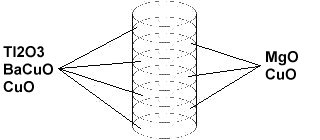



Though it took a year, Superconductors.ORG herein announces that a way has been found to further increase the record high Tc of (Tl4Ba)-9223 from 254K to 258K. This extraordinarily high transition temperature was achieved by substituting magnesium into the calcium atomic sites of the 16-layer 9223 structure that produced 254K superconductivity in 2009. The new formula thus becomes (Tl4Ba)Ba2Mg2Cu7O13+.
When 4-point resistance tests were performed on a sample pellet, multiple plots displayed a sharp resistive transition near 258 Kelvin (-15C, 5F), as shown at page top. This is the first observation of superconductivity over 0F. While four degrees Kelvin is not a huge increase in high Tc, this discovery again validates planar weight disparity as a prolific Tc enhancement tool. It also illustrates the challenges in trying to improve superconductor performance as we approach room temperature.

|
A meissner transition was observed near 260K in this material, as shown below.
 Previous world records were all attained by exploiting planar weight disparity along the "C" (vertical) axis. And this discovery is no exception. Since magnesium is 40% lighter than calcium and also has a +2 oxidation state, it was chosen to replace calcium. When Mg occupies the same atomic sites as Ca, the planar weight ratio (PWR) increases by X/(1-0.40) along the C2 axis. The C1 axis PWR remains static at 5.0 (see graphic at left). The unit cell is slightly smaller. |
Since the ionic radius of magnesium is near that of copper, 0.72Å - v - 0.73Å, synthesizing this compound bulk would have placed Mg in many of the Cu sites. So instead, synthesis was by the "layer cake" method (see below graphic). Using the layer cake method fewer copper sites are exposed to magnesium atoms. So a sufficient volume fraction of the desired structure can form to be detected. The two pellets tested had between 18 and 20 layers each.

A dot has been placed within the C1 plot below, depicting where (Tl,Ba)-9223-Mg lies relative to the other high performance thallium-cuprates.

Within this material were signs of an even higher Tc "minority phase". To read about the discovery of a 265K superconductor, CLICK HERE.
As with prior discoveries that are asymmetrical along the C axis, the volume fraction of the 258K material is low (<1%). So commercialization will have to wait for a refining method to be developed to increase the VF. As a result of a low VF, numerous R-T and magnetization tests may be necessary to see the respective transitions above the noise. This discovery is being released into the public domain without patent protection in order to encourage additional research. Synthesis was by the solid state reaction method.
The below stoichiometric ratios were used for the ODD layers:
Tl2O3 99.99% (Alfa Aesar) 7.61 grains...and the below stoichiometric ratios for the EVEN layers.
MgO 99.95% (Alfa Aesar) 0.67 grainsThe chemical precursors were pelletized at 70,000 PSI and sintered for 35-36 hours at 865C. The pellet was then annealed for 10 hours at 500C in flowing O2. The magnetometer employed twin Honeywell SS94A1F Hall-effect sensors with a tandem sensitivity of 50 mv/gauss. The 4-point probe was bonded to the pellet with CW2400 silver epoxy and used 7 volts on the primary.
RESEARCH NOTE: The copper-oxides are strongly hygroscopic. All tests should be performed immediately after annealing.
E. Joe Eck
© 2010 Superconductors.ORG
All rights reserved.
 BACK to "News" page at Superconductors.ORG
BACK to "News" page at Superconductors.ORG